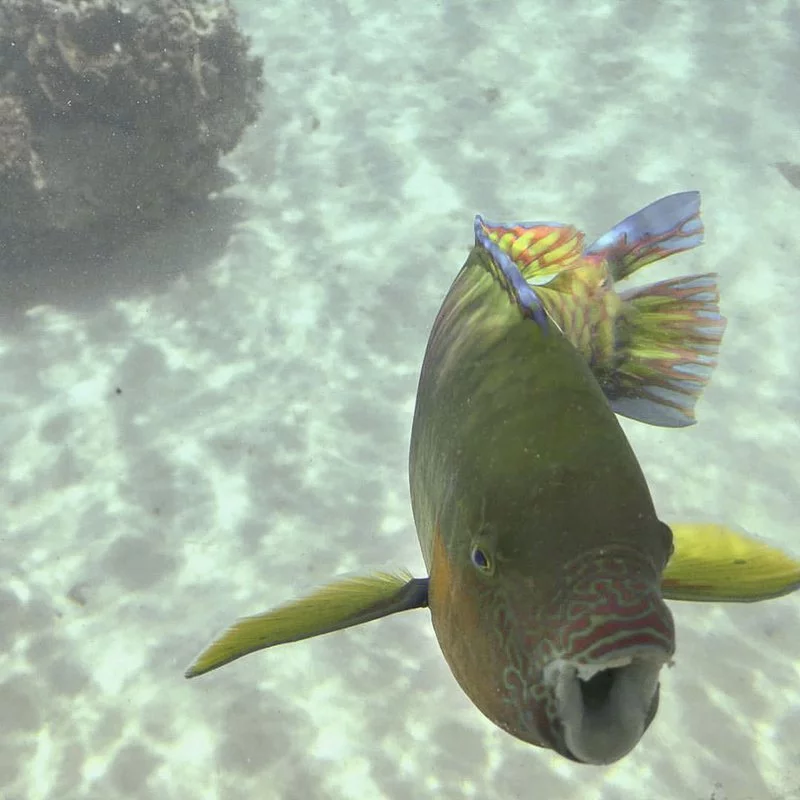The pretty parrotfish and their peculiar ways
Parrotfish are one of the most eye-catching species we tend to see whilst snorkeling. Wings Sailing Charters Whitsundays guests often bursting with excitement, wanting to know “what’s that rainbowfish?!”. They are quite prominent in the Whitsunday Islands and surrounding reefs, and as such we are lucky enough to see them nearly every time our guests jump in the water. What you might not know is that these colourful creatures are more than just a pretty face, they have some crazy secrets and play an important role in the reef ecosystem.
Though the fantastic colours of the parrotfish can look very much like the exotic bird-life you see in a tropical rainforest they actually get their name from their beak like teeth. The parrotfish’s front teeth are fused together and poke out from the mouth, making them look very much like a bird’s beak. The ‘beak’ of a parrotfish is incredibly strong and used to munch on their favourite food, coral! When they are busy munching away if you listen carefully you can even hear them scraping the corals with their tough beaks and see the bite marks where they have been grazing.
This may sound like a bad thing for our reefs, however parrotfish are very important. They munch on the algae on and inside the coral, helping clean up diseased corals and algae overgrowing coral colonies. When the parrotfish nibble away they help keep the reef healthy and allow fresh areas for young coral polyps to land and settle, starting new colonies.
They are also important for another reason, parrotfish help create sand! Often taking a little bit of the hard coral skeleton when they are eating, the parrotfish are unable to digest this material. Instead it gets ground up during digestion and excreted (pooped out) to give us sand! Some individual parrotfish in the larger species can create up to 90kg of sand a year! The process that the parrotfish take place in is called bioerosion.
As mentioned earlier parrotfish come in a range of vibrant colours similar to exoctic and tropical birdlife, making them incredible to watch as they dart around the reef. The colouration and patterns of parrotfish varies between species, and even individual fish as they mature and grow. Colours can also differ depending on whether they are male or female. Originally many parrotfish were identified by their colour and patterns alone, at this time scientists believed there were up to a couple hundred species. However with a little further investigating it has been found that there are actually only around 80 distinct species of parrotfish.
Parrotfish are quite gifted as well, they have the ability to change sex throughout their lifetime! Typically starting off as females parrotfish have the ability to change sex as they grow. Males are able to make large amounts of sperm relatively easily compared to females producing the same amount of eggs, as a result one male can reproduce with many females. The male parrotfish will often have a harem of females who follow him around, as he offers a good mating opportunity and protection of sorts. If something were to happen to the male leading the harem or the male population in the area female parrotfish have the ability to change sex completely. This process starts with a challenge between the larger females, the winner of the challenge will then change sex completely inlcuding inernal organs and external appearnace to become male.
These tricky critters have one final trick up their sleeve, though it is a little gross. Many parrotfish have the ability to make themselves a sleeping bag or cocoon, this helps keep them safe from nocturnal predators. They make the cocoon from a slimy mucous surrounding themselves at the start of the night, and will not emerge until morning. The mucous helps mask the scent of the parrotfish and has even been found to contain antibiotic properties!
Certainly now you can see the parrotfish have some most peculiar habits and hidden talents! If you would like to meet these crazy fish or learn a little more about them and their unique ways come on out and join our wings crew exploring the Whitsunday Islands and their reefs!

